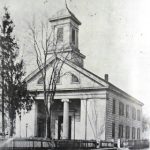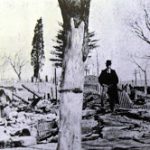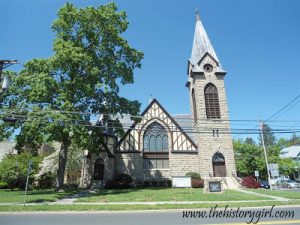In a community that has been often plagued by floodwaters of the swelling Raritan River and its tributaries, Bound Brook, New Jersey is rich in heritage and architecture. Up quite a few blocks from the historic downtown is an imposing church edifice known as the Bound Brook Presbyterian Church. Its tall steeple reaches for the heavens, constructed at a time when elaborate churches were commonplace and all extravagances were included to show off the devotion of its congregation. Over one hundred years later, the church still stands proud amidst a large restoration project to return this beloved but weathered church to its original state of opulence.
Tradition states that a church congregation at Bound Brook was established as early as 1688 by Covenanters. The Covenanters were first formed as a congregation in the dark dungeons of Dunnottar Castle in seventeenth century Scotland. This small group of 167 men and women, called “Covenanters,” for their support of covenant agreements intended to defend and extend Presbyterianism, were persecuted for their beliefs and imprisoned in the Castle. As part of a plan to settle East Jersey in the New World, the prisoners were freed and arrived in Perth Amboy in December, 1685. The Covenanters were the most determined of the Scotch Presbyterians whose religious philosophy was based upon the principles of the Celtic Church. Upon arriving, they were not welcomed by the coastal residents, but a small number were warmly received in Woodbridge. These early settlers made their way out toward Piscataway and what would become Bound Brook along the new road that followed the Raritan River. In 1688, Bound Brook existed more as a location than as a village. There were only four homes at the time. The lands encompassing Bound Brook were purchased from the Raritan Indians. As settlement increased, the Covenanters encouraged others to join their gathering, which would have most likely been held in members’ homes or in a temporary log building constructed just for the purpose of services.
In 1725, the first documented church building was built. The building held one hundred pews and was built in the style of a meeting place rather than a formal church building. It was located on Main Street near East Street, in Bound Brook.
At some point between 1700 and 1744, a cemetery was established by the congregation behind the church. In 1907, the oldest legible stone recorded a death in 1744 for Sarah McCoy, but historians believe the graveyard existed earlier than that date. Known locally as the Old Presbyterian Graveyard, it is located at the corner of East High Street and East Street. The two acre site has also been sometimes referred to as the Revolutionary War Cemetery and the Pre-Revolutionary Graveyard. It is estimated that there are approximately seventy Revolutionary War soldiers buried in the graveyard, about forty-five of which are identified, three of the War of 1812, one of the Mexican War and four of the Civil War. It is estimated that there may be as many as 1,000 to 1,500 people buried in the cemetery. Over the years, as time, vandalism, and neglect took their grasp on the property, many headstones were lost, removed, or disintegrated including two family vaults. There are approximately 600 known interred who were placed in marked graves and an unknown number in unmarked graves.
By 1760, the congregation had outgrown the 1725 building and a larger church was erected that year. The building was erected near the corner of Main and East Streets. Thirty-eight pews filled the church and the pulpit was at the north end. The pulpit was a high box with a door on each side and above it was a large sounding board. In 1787, the building was enlarged to seventy-six pews, further evidence of the congregation’s growth.
Between 1828 and 1829, the Bound Brook Presbyterian Church was led by Reverend Sylvester Graham. Graham was very interested in temperance and various health regimens. In 1829, Graham developed the graham cracker to cure the dreaded fever of lust. The original cracker was conceived as a health food and contained graham flour and considerably less sweeteners than the cookie-cracker known today. Reverend Graham was the founder of an entire diet known as the Graham Diet that was meant to suppress “unhealthy carnal urges”, of which “Graham Bread” (as it was then known) played a part.
Services were held in the 1760 church building until 1829. That year, the church was torn down and a new church building was constructed on the same site. At $3,800, Richard Field Giles was contracted as the builder and advised to reuse as much material from the original building that was salvageable. The church was sixty-four feet long, by fifty-two feet wide. The design included two large fluted columns rising twenty-six feet high at the gable end fronting the main entrance and a coupla similar in design to that on the College of New Brunswick. The building contained 104 pews and was completed by November, 1829.
Because of periodic flooding and the congregation’s growth, a new site on Mountain Avenue was purchased in 1890. Plans were developed for a larger replica of the 1829 church. The proposed classical design, to be entirely of wood construction, was approved on January 27, 1896.
On February 6, 1896, a terrible fire destroyed the 1829 church. A heavy rain flooded Bound Brook and it reached the limehouse at the lumber yard next door to the church, which spontaneously combusted. According to the Bound Brook Chronicle, the lime was unslacked. Sparks were carried by the winds and eventually reached the belfry of the church. The February 22, 1896 edition of the Illustrated American reported, “Nothing could be done to save the old building, for the flood, dangerous enough by daylight, could not be ventured into at night, so within an hour nothing of the church remained but a bit of the chimney.” Reverend Titus Davis, James McNabb, and two other men entered the building through the back door, walking on the backs of the pews through the floodwaters and carried out the small chapel organ that was on the balcony, the pulpit bible dating to 1784, the collection plate, and a few hymn books. The metal from the bell in the steeple was salvaged. Cast in 1870, it was melted down into many smaller bells, one of which is still in the possession of the church, in addition to molten glass. A burned shingle from the building was saved and placed in the new church’s cornerstone.
Five days after the fire, a new Building Committee was formed and a new architect, Oscar S. Teale, of Newark, was engaged. The Building Committee called for the replacement church to be of “a friendlier design, not at all ostentatious, but to reflect religious reverence and social protocols.” Oscar Teale scrapped the previous plans for designing the church as a replica of its predecessor and totally revised the building design. The new design incorporated rugged Martinsville stone walls with plaster and half-timber. A slate roof and Tudor arches were skillfully combined in a medieval revival style. A one hundred foot tall steeple emphasized the main entrance, and the diagonal axis within. The building originally included a porte-cochere, a rarity for church buildings (it has since been closed in and serves as office space).
The cornerstone was laid just five and one-half months after the fire on August 1, 1896. Starting with a simple square plan fifty-six feet wide, Teale set the major axis of the sanctuary on a forty-five degree angle allowing a circular pattern of seating, with equality of viewing of organ, choir, and pulpit. With the flowing curves of the beautifully detailed balcony and the softened and curved corners – the square plan all but disappears. The main floor was designed to hold about 400 and the gallery 100. William Farrior was the general contractor, William Bartle, mason, James Vosseller, carpenter, and Willis Stryker, painter.
The lofty spaces, wooden trusses, square in pattern, and arched plaster ceilings amplify the external stone arches and frame. The south-facing stained glass window was designed and installed by Louis Comfort Tiffany. One window shows Jesus knocking at the door; the other window features Ruth gleaning the fields.
The church was initially designed for gas lamps but electricity and telephone service arrived in Bound Brook in 1896, allowing the edifice to be among the first to utilize these new technologies. The church was dedicated on June 30, 1898. The total cost to construct the building was $35,000.
Over the next one hundred years, the Bound Brook Presbyterian Church began to show signs of age. Vermont slate shingles and flashing began deteriorating, causing leaks and damage to interior plaster, birds made nests in rotting soffit and exterior woodwork, and the building’s masonry showed signs of deterioration and water infiltration due to freeze/thaw cycles. Realizing the importance of this magnificent house of worship and its integrity, church officials hired an architect and developed a historic preservation plan, resulting in the church’s inclusion on the New Jersey and National Registers of Historic Places in 2007. Since then, the church has been raising funding through a capital campaign and grants from the New Jersey Historic Trust in order to repair the church and retain its historical integrity for another 100 years.
Additional photos of my trip to
The Presbyterian Church at Bound Brook on Pinterest






